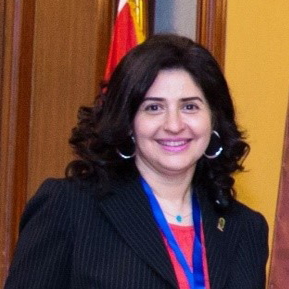Abeer A Mahrous, PhD, Professor of Marketing, Cairo University, Egypt
Deputy Editor in Chief of JHASS

The quality of the peer review process is the heart of the academic publishing system. Ideally, the peer-review process is gender-neutral.
Recently, the gender perspective of the peer review process received increasing attention from the participants in the publishing process because of increased evidence of the systematic underrepresentation of women as authors, reviewers, and editors (Squazzoni, 2021).
Although the number of female authors, reviewers, and editors in top-tier journals slightly increased in the past two decades, the underrepresentation of women is still observed in many academic fields (Enago.com, 2020). For example, in the humanities and social sciences fields, where women's contributions were noticeable, there is still a pertinent gap between male and female researchers (Willis et al., 2021; Lerback and Hanson, 2017).
Furthermore, in analysing thousands of submissions in influential journals in the sciences, only about 20% of peer reviewers and 25% of editors are female. Moreover, most female reviewers were from developed countries such as the US, UK, and other European countries. On the other hand, less than 2% of the peer reviewers were female from emerging economies such as China, India, and South Africa (Chawla, 2018).
The editorial processes do not discriminate against women. the gender gap in the peer review process is probably because female is underrepresented in the research process, as this is the pool that editors search to find reviewers. The underrepresentation of women as authors, reviewers, and editors may be because of women's too conscious career choices. Female academics sometimes have more teaching and administrative duties (Krishen et al., 2021) and more household responsibilities (Mahrous, 2019). Moreover, recent data shows that COVID-19 has significantly reduced female publications even further, which will have an impact on the peer-review gender gap in the future
(Ribarovska et al., 2021).
Given the persistent and unconscious nature of gender bias in the publication process, the underrepresentation of women is a problem that will not solve by itself. There should be policies to get more female voices involved in the peer-review process and the broader publication process. Accordingly, the peer review process shouldn't be dependent on local and personal networks or be dominated by certain geopolitical preferences (Lendák-Kabók and Ochsner, 2021).
The underrepresentation of women in peer-review and editorial positions can negatively influence women's perceptions of their competence and potential progress as academics. Diversity and inclusion are beneficial in sciences and innovation in general; however, diversity in the publication process, especially in peer review and editorial positions, can send positive signals to early-career female researchers and help shape a more hospitable social construction of female participation in academia.
In the long run, attention should be given to discovering the barriers women and other underrepresented authors confront in gaining entry to the publication process and remove them. However, in the short run, a simple policy to decrease the gender gap would be to increase gender, race, and other demographic factors diversity in the editorial leadership, editorial teams, and referee pools. Such a policy will help inform potential authors about journals and publishing companies' attention on identity parity and stimulate female and other underrepresented groups' contributions (Rouan et al., 2021; Chawla, 2018). Moreover, study results show that men and women have the same probability of accepting an invitation to review manuscripts in scholarly journals (Helmer et al., 2017). Therefore, inviting more women will lead to less gender gap in the peer-review process.
Another way to eliminate publication bias requires diversity and inclusion measures and reports and communicating these benchmarks to the wider academic community. Additionally, alternate forms of peer review (e.g., open, collaborative, and post-publication) could decrease the selection of referees from personal networks and stimulate more female and other minorities' contributions in the peer-review process. Finally, another policy to consider is to build training programs for editors and editorial teams to make them aware of all sorts of publication bias and how to overcome it.
References
Chawla, D. S. (2018). Huge peer-review study reveals a lack of women and non-Westerners. Nature, 561(7722), 295-297.
Enago.com (2020), Why are Women Underrepresented in the Area of Research? Retrieved from https://www.enago.com/academy/sexism-in-science/ (accessed 06/09/2021)
Helmer, M., Schottdorf, M., Neef, A., & Battaglia, D. (2017). Gender bias in scholarly peer review. Elife, 6, e21718.
Krishen, A. S., Lee, M. T., & Raschke, R. L. (2020). The story only few can tell: Exploring the disproportionately gendered professoriate in business schools. Journal of Marketing Education, 42(1), 7-22.
Lendák-Kabók, K., & Ochsner, M. (2021). PART IV: Current Challenges for Peer Reviewing: Towards More Open and Gender-Sensitive Peer Reviewing Practices in the SSH.
Lerback, J., & Hanson, B. (2017). Journals invite too few women to referee. Nature News, 541(7638), 455.
Mahrous, A. A. (2019). Female entrepreneurship in Egypt: new theoretical and public policy implications. Маркетинг і менеджмент інновацій, (1), 151-160.
Ribarovska, A. K., Hutchinson, M. R., Pittman, Q. J., Pariante, C., & Spencer, S. J. (2021). Gender inequality in publishing during the COVID-19 pandemic. Brain, behavior, and immunity, 91, 1.
Rouan, J., Velazquez, G., Freischlag, J., & Kibbe, M. R. (2021). Publication bias is the consequence of a lack of diversity, equity, and inclusion. Journal of Vascular Surgery, 74(2), 111S-117S.
Squazzoni, F., Bravo, G., Farjam, M., Marusic, A., Mehmani, B., Willis, M., ... & Grimaldo, F. (2021). Peer review and gender bias: A study on 145 scholarly journals. Science advances, 7(2), eabd0299.
Willis, M., Bridges, A. J., & Jozkowski, K. N. (2021). Gender and racial/ethnic disparities in rates of publishing and inclusion in scientific-review processes. Translational Issues in Psychological Science.
Biography
Abeer A. Mahrous, Ph.D., Professor of Marketing at Cairo University and Deputy Editor in Chief of the Journal of Humanities and Applied Social Sciences, JHASS. Her research focuses on digital marketing, neuromarketing, tourism marketing, social marketing, and sustainable consumer behavior. She published more than 30 refereed articles in top journals and conferences in Marketing and Business Administration such as Journal of Business Research, Journal of Travel Research, and Journal of Research in Interactive Marketing. In addition, she co-authored books published internationally and nationally. Furthermore, she established a scientific school of thought on the use of new technologies in marketing, and the contributions of this school included several important research at the doctoral level and research published in prestigious scientific journals. She also carried out research projects funded by Cairo University and international organizations.
Contact info
Email: [email protected]
Website: https://scholar.cu.edu.eg/?q=abeer/
LinkedIn: Abeer A. Mahrous
Facebook: Abeer Mahrous
